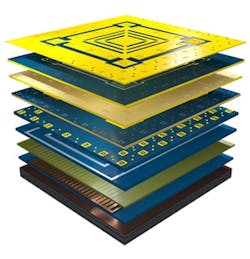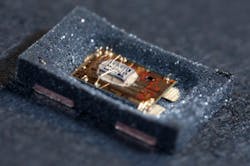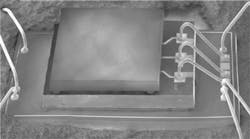This file type includes high resolution graphics and schematics when applicable.
Digital, analog, and RF applications are requiring ever-greater performance from oscillator technology—specifically in terms of size, cost, and frequency. Skyrocketing data rates, military precision, and millimeter-wave technologies are at the forefront of these demanding applications. Fortunately, a consistently scaling technology method may be able to satisfy these demands. For example, complementary-metal-oxide-semiconductor (CMOS) processes may be reaching a performance level that enables microelectromechanical-systems (MEMS) technology to replace the comparatively bulky crystals in the latest oscillators (Figs. 1 and 2).
Such a move would drastically change the industry, as quartz-crystal technology for precision frequency control and timing has dominated the market since 1917 (when the first crystal-controlled oscillator was patented). The first quartz-crystal clock was developed in 1928. In the 1950s, atomic clocks were used, although their materials are generally too large and costly for use in most modern electronic applications. In the early 2000s, other technologies finally began catching up to the resonate performance of quartz crystals.
Quartz-crystal resonators operate according to the principle dictating that elastic materials have resonant frequencies of vibration. The resonant frequency of a material depends upon its size, elasticity, speed of sound, and shape. As long as they are properly cut and mounted, quartz crystals will physically distort in the presence of an electric field when a voltage is applied to an electrode near the crystal. This electrostriction, or inverse piezoelectricity effect, causes a resistive, capacitive, and inductive (RLC) resonant-circuit-like response at a very precise resonant frequency. Crystal resonators can be manufactured to resonant frequencies ranging from a few kilohertz to several hundred megahertz.
The manufacturing process for performance crystals requires specialized equipment and hermetic sealing. Often, it also demands temperature-control technologies in complex packages that can support these options. Such specialized manufacturing stages are required to mitigate the limitations of quartz-crystal technology. The higher the frequency of resonance, the more susceptible this technology is to interference from parasitics. After all, any additional capacitance or inductance will cause shifting in the resonant frequency. Furthermore, a higher frequency of operation tends to lead to sensitivities and loss of performance at temperature and vibration variations. Compensating for these limitations requires ever-greater steps to control the temperature and buoy the resonating element to provide protection from vibrations.
With the telecommunications, test and measurement, military, and space markets demanding ever-smaller footprints for oscillator technologies, development has been increasing for technologies without these limitations. Surface-acoustic-wave (SAW) and bulk-acoustic-wave (BAW) resonators have been used for oscillation technologies. Yet they suffer many of the same size, cost, and reliability issues as quartz-crystal technologies. Over the past few years, other methods have finally surfaced at companies like Silicon Labs, Toshiba, Vectron, SiTime, Synergy, Sand9, Micrel, Discera, and others. They are producing MEMS-based oscillators in very small and flat packages (Fig. 3). To create the final oscillator device, the earlier versions of this technology still rely on a MEMS resonator chip packaged with another IC in a multichip module (MCM).
MEMS MCM specialized packages require fabrication facilities with unique capabilities. Unfortunately, relying on non-mainstream technology tends to drive up costs while slowing iterative improvements. Additionally, strain and rapid temperature fluctuations are still significant performance degraders for MEMS MCM technology, which has only just reached quartz-crystal-oscillator capabilities (Figs. 4). A logical next step is to integrate all of the oscillator elements onto a single die that can be manufactured in a standard process. CMOS technology nodes, for instance, continue to increase in performance and capabilities. As a result, many technologies are moving to CMOS to enable the development of miniature and cost-effective solutions.
This file type includes high resolution graphics and schematics when applicable.
Looking Forward
This file type includes high resolution graphics and schematics when applicable.
Developing clever circuit techniques and process investigation may be a large R&D expense. Yet the wide adoption, low costs, high yield, fabrication options, and upgradability of using a CMOS process for oscillator technologies could outweigh the initial investments. Among the companies that are already developing high-performing CMOS MEMS oscillators, which are resilient and take advantage of the advanced circuit techniques enabled by CMOS processing, are Silicon Labs, Toshiba, Discera, and Micrel. Because the addition of MEMS would occur at a post-processing stage for CMOS circuitry, the CMOS MEMS can be integrated into the latest mixed-signal/RF technologies.
Silicon and polycrystalline silicon germanium (poly-SiGe) are common structural materials for CMOS-based MEMS oscillators. Poly-SiGe lends itself to sophisticated multistep processing, as it exhibits low thermal losses, high fracture strength, and limited hysteresis/creep when subjected to multiple stress cycles. These traits also are desirable for frequency-control applications, thanks to their propensity for long-term stability. In addition, the CMOS MEMS process provides the ability to integrate a frequency-control structure directly into a mainstream device. This aspect eliminates the need for costly and bulky interconnects between the frequency control device and the ICs that need control. It also eliminates any potential parasitics that could occur as a result.
Initially, MEMS resonators suffered from low transduction efficiency, large frequency temperature coefficients, and difficulty with trimming. Such issues were a function of the small size and special processing that was needed. All of these drawbacks can, and have, been effectively mitigated by the use of clever circuit techniques and the processing stages enabled by the CMOS integration. For example, temperature susceptibility can be reduced by mechanically compensating for the physical effects of the temperature on the substrate using a material with an opposite temperature coefficient (namely silicon dioxide, which is readily available in a CMOS process). For frequency-control devices, CMOS MEMS provide benefits beyond high-performance oscillators. They could even enable highly precise and small-form-factor sensors and transducers.
With the increasing frequency range and miniaturization of the latest RF/microwave/millimeter-wave technologies, there is a demand for technologies that provide even higher frequency and performance. The Resonant MEMS Group, part of the Wireless Integrated MicroSensing & Systems (WIMS2) Center at the University of Michigan, is looking to gallium nitride (GaN) and phase-change compounds to enable the next-generation RF MEMS devices. According to Dr. Mina Rais-Zadeh, head of the Resonant MEMS Group, “An interesting direction for GaN research, which is largely unexplored, is GaN-based microelectromechanical-systems devices. To fully unlock the potential of GaN and realize new, advanced, all-GaN ICs, it is essential to co-integrate passive devices (such as resonators and filters), sensors (such as temperature and gas sensors), and other more-than-Moore functional devices with GaN active electronics.”
A wide-bandgap semiconductor, such as GaN, has greater ability than silicon (Si) to handle high power and temperature extremes. With similar electron mobilities and an already developed industrial presence that is second only to Si, GaN can be used to form thin aluminum (Al) GaN/GaN heterostructures. These structures exhibit the 2D electron-gas phenomenon, which enables them to form high-electron mobility transistors (HEMTs) with a high Johnsons’ figure of merit.
GaN also boasts piezoelectric properties and low acoustic loss, which make it ideal for high-quality-factor resonators and low-phase-noise oscillators. “While not having sufficient piezoelectric coupling for filter applications, the piezoelectric constant of GaN is large enough to implement low-power oscillators,” notes Rais-Zadeh. “Besides, GaN bulk acoustic wave resonators are small in size and can be monolithically integrated with GaN/AlGaN HEMTs to implement a small-form-factor, very linear, and low-noise oscillator.”
Other factors that may enable very-high-performing frequency-control devices from GaN technology include the material’s high electrical breakdown field, high electron-sheet charge density, the absence of ionized impurities in the undoped hetero-structure, and the ability to develop high-Q MEMS resonators. These traits could enable higher power-density signals from GaN devices while limiting the nonlinearities that are introduced into those signals. Additional benefits may include improved oscillator noise performance and reduced phase noise. They also will experience less timing jitter than the GaN oscillators made with inductive-capacitive tank-circuit, microstrip, coaxial, or SAW resonators.
Developing a time-invariant and environmentally stable frequency-control device is a challenge with every current technology, and it is no different with GaN MEMS. Rais-Zadeh states, “The other challenge with oscillators based on MEMS resonators, in general, is the stability of the frequency with environmental changes. This has been successfully addressed using silicon as the resonating material. And similar techniques can be adapted to implement frequency-stable GaN-based oscillators.”
Until the performance enhancements are more apparent, additional adoption challenges may surface due to the cost of growing GaN on an easily micromachined and low-loss substrate in a cost-effective manner. Rais-Zadeh comments, “This technology offers lower noise and lower power consumption compared to competitive RF/microwave oscillators. However, because the technology is not as mature, the cost may be higher now. But the cost can be substantially reduced if one goes to large-volume manufacturing.” With GaN technology being adopted more rapidly throughout the RF/microwave industry, more devices may be using this semiconductor technology in the not-too-distant future. “ I envision three to five years before the GaN MEMS-oscillator technology reaches the market,” predicts Rais-Zadeh. The desire to have modules with completely integrated RF/microwave electronics and the growth of highly integrated millimeter-wave applications also may drive the rapid development of this technology.
In fact, many companies and research groups are backing the use of MEMS to replace a lot of the larger, more costly, power-consuming, and difficult-to-integrate technologies. Frequency-control products, such as oscillators, are a hot topic for innovation because they are necessary components in almost every electronic device. Quartz-crystal-based oscillators—though highly refined—are still limited in their SWaP-C performance. In addition, the latest applications are demanding higher frequencies and more scalable technologies. It may only be a matter of time before more mainstreamed RF/microwave technologies, such as CMOS and GaN MEMS devices, outstrip crystal performance and herald an age of smaller, higher-frequency, and better-performing frequency-control devices.
This file type includes high resolution graphics and schematics when applicable.





